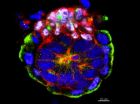(Press-News.org) Austin - February 13, 2014 - Social media can do more than just entertain us and keep us connected. It also can help scientists better understand human behavior and social dynamics. The volume of data created through new technology and social media such as Facebook and Twitter is lending insight into everything from mapping modern family dynamics to predicting postpartum depression.
"By analyzing different types of social media, search terms, or even blogs, we are able to capture people's thinking, communication patterns, health, beliefs, prejudices, group behaviors – essentially everything that has ever been studied in social and personality psychology," says James Pennebaker, president of the Society of Personality and Social Psychology (SPSP), which is kicking off its annual conference today in Austin. "We can examine thousands, even hundreds of thousands of people at once or track them over time."
Pennebaker of the University of Texas-Austin, whose work has explored the power of language in revealing our personality and behavior, is chairing a session today on the opportunities enabled by big data and new technology. No longer do research psychologists need to rely on traditional experimental designs, "running one upper middle class college student at a time," he says. "We now have access to the world of social behavior in ways never imagined before."
For example, a recent study by research scientists at Facebook analyzed 400,000 Facebook posts to determine differences in how parents talk to their children versus other friends and how they address their adult versus teen children. The posts, stripped of identifiable user information, showed that children's communication with their parents decreases in frequency from age 13 on, but then rises when they move out. Counter to previous research on familial communication, they also found that being farther away from each other does not diminish how much parents and children talk on Facebook.
The study also found differences between how mothers and fathers use Facebook. Automatic language coding showed that mothers' posts showed more emotion, using phrases like "poor baby" or "so proud of," while fathers' posts were more abstract, with phrases such as "keep it up" or "got your back." Also, mothers were more likely to ask children to call them, while fathers talked more about shared interests, such as politics or sports.
"The Internet offers a tremendous opportunity to understand important social phenomena like family structure and also to help us explore how sharing information influences people's emotional states and decision-making," says Adam Kramer, a data scientist at Facebook. Kramer will be presenting such varying examples at the SPSP conference in Austin today.
Eric Horvitz, distinguished scientist and director of Microsoft Research lab in Redmond, Wash., has been analyzing data from Twitter and other online media to better understand and predict people's health and well-being. "Large-scale data analyses generate insights about people – their mood, goals, intentions, health, and well-being – over both short and long periods of time," he says.
In recent work, Horvitz and colleagues used Twitter to identify 376 new mothers who might be at risk of postpartum depression. They analyzed some 36,000 tweets during the 3 months leading up to the births and some 40,000 tweets for 3 months after the births to detect changes in mood and behavior. They looked at everything from networks of social engagement to word usage, using Pennebaker and colleagues' measures of language shifts linked to downward mood shifts. For example, one potential indicator of postpartum depression is a shift from using third-person pronouns to first-person pronouns. Other indicators include a decrease in volume of tweets, a shrinking in the moms' social networks, and use of words indicating negative mood.
Based on these factors, Horvitz's team constructed a predictive model that can forecast significant postpartum shifts in mood in new mothers, using only observations available before the births. The model can identify mothers at risk of having such dramatic mood shifts as accurately as 70%. Next, the researchers need to test their model with women who have been already diagnosed with postpartum depression.
In other recent work, Horvitz and colleagues used participant reporting, along with pattern and network analysis, to examine the onset of major depressive episodes. His team first identified about 1,500 people with depression through an online assessment tool and then gave them the option of providing their Twitter handles. The researchers were then able to look at the Twitter feeds of the approximate 630 people who opted in to identify factors that predict the onset of major depressive disorders.
The hope, Horvitz says, is to develop new public health tools by leveraging the vast data available via social media with machine learning and linguistics analysis. He is also working on projects aimed understanding how women cope with breast cancer diagnoses, by analyzing patterns among anonymized Web search logs. Other work has explored how cognitive biases interact with search engine biases to fuel phenomena such as "cyberchondria" – the rise in anxiety about rare illnesses during Web searches of common, benign symptoms.
"We have reached an intriguing moment, perhaps unprecedented, when the data available to a handful of private companies – for example, Google, Facebook, Twitter, – could in principle make enormous impacts on social science research, especially social and personality psychology," says J.B. Michel of the Institute for Quantitative Social Science at Harvard. With Erez Aiden, Michel recently used millions of books digitized by Google to build a scientific tool for measuring trends in our shared culture, history, and language going back hundreds of years.
"Never before could we in principle know so much about so many people over such long periods of time with such ease. But, these data are virtually unused in this way," Michel says. "Addressing this divide is, in my mind, a transformative opportunity for the community of researchers interested in the human experience."
Social media is not the only tool scientists have in gathering bigger data. Roxane Cohen Silver of the University of California, Irvine, has been using online surveys to study how people cope with trauma in the aftermath of disaster. "The ability to collect data online after national events is far more efficient and useful than the prior way of collecting post-disaster data from representative samples, which required collecting data by telephone using 'random digit dialing,'" Silver says. She has studied the effects of 9/11 and more recently the Boston Marathon bombing, linking repeated media exposure in the early aftermath of the disaster to greater acute stress than being directly at or near the marathon.
Now Silver, with colleague Baruch Fischhoff from Carnegie Mellon University, is planning a project using a mobile app to study communities at-risk for severe weather events. "The goal is to collect assessments of risk, thoughts, and feelings before a hurricane, during the storm, and post-disaster reactions over time," she says.
As technological capabilities grow, so too will the possibilities for research psychology. "Look around you," Pennebaker says. "Ask your friends about their reliance on electronic communication. And then start figuring out ways to harness this technology to understand the world around us."
INFORMATION:
The session, "Expanding Social and Personality Psychology: Big Data and New Technology," is taking place on Thursday, Feb. 13, 2014, at the SPSP annual conference. More than 3,500 scientists are in attendance at the conference in Austin from Feb. 13-15.
Horvitz and Pennebaker also will be presenting some of this work next week at the annual meeting of the American Association for the Advancement of Science (AAAS) in Chicago.
SPSP promotes scientific research that explores how people think, behave, feel, and interact. With more than 6,000 members, the Society is the largest organization of social and personality psychologists in the world. Follow us: @SPSPnews
For understanding family structure to trauma: New technology is yielding bigger data
2014-02-14
ELSE PRESS RELEASES FROM THIS DATE:
Genetic chip will help salmon farmers breed better fish
2014-02-14
Atlantic salmon production could be boosted by a new technology that will help select the best fish for breeding.
The development will enable salmon breeders to improve the quality of their stock and its resistance to disease.
A chip loaded with hundreds of thousands of pieces of DNA – each holding a fragment of the salmon's genetic code – will allow breeders to detect fish with the best genes.
It does so by detecting variations in the genetic code of each individual fish – known as single nucleotide polymorphisms (SNPs). These variations make it possible to identify ...
Discovery may help to explain mystery of 'missing' genetic risk
2014-02-14
A new study could help to answer an important riddle in our understanding of genetics: why research to look for the genetic causes of common diseases has failed to explain more than a fraction of the heritable risk of developing them.
Susceptibility to common diseases is believed to arise through a combination of many common genetic variants that individually slightly increase the risk of disease, plus a smaller number of rare mutations that often carry far greater risk.
However, even when their effects are added together, the genetic variants so far linked to common ...
Mixed genes
2014-02-14
This news release is available in German. When individuals from different groups interbreed, their offspring's DNA becomes a mixture of the DNA from each admixing group. Pieces of this DNA are then passed along through subsequent generations, carrying on all the way to the present day. Researchers from the Max Planck Institute for Evolutionary Anthropology in Leipzig, Germany, Oxford University and University College London (UCL) have now produced a global map detailing the genetic histories of 95 different populations across the world, spanning the last four millennia.
The ...
Study highlights indigenous response to natural disaster
2014-02-14
DENVER (Feb. 13, 2014) – When a tsunami struck American Samoa in 2009, indigenous institutions on the islands provided effective disaster relief that could help federal emergency managers in similar communities nationwide, according to a study from the University of Colorado Denver and the University of Hawaii at Manoa.
The study found that following the tsunami, residents of the remote U.S. territory in the South Pacific relied on Fa'aSamoa or The Samoan Way, an umbrella term incorporating a variety of traditional institutions governing the lives of its citizens.
"We ...
Berkeley Lab researchers at AAAS 2014
2014-02-14
Can more accurate climate models help us understand extreme weather events? Can we use
synthetic biology to create better biofuels? These questions, and the ongoing search for Dark
Matter and better photovoltaic materials, are just some of the presentations by Lawrence
Berkeley National Lab researchers at this year's AAAS meeting. Here's a quick look at Berkeley
Lab@AAAS:
Friday, Feb. 14
1:00-2:30
Opportunities for New Materials in
Photovoltaics (Toronto Room, Hyatt Regency)
Ramamoorthy Ramesh
The
Department of Energy's ...
Superconductivity in orbit: Scientists find new path to loss-free electricity
2014-02-14
UPTON, NY—Armed with just the right atomic arrangements, superconductors allow electricity to flow without loss and radically enhance energy generation, delivery, and storage. Scientists tweak these superconductor recipes by swapping out elements or manipulating the valence electrons in an atom's outermost orbital shell to strike the perfect conductive balance. Most high-temperature superconductors contain atoms with only one orbital impacting performance—but what about mixing those elements with more complex configurations?
Now, researchers at the U.S. Department of ...
Rewriting the text books: Scientists crack open 'black box' of development
2014-02-14
We know much about how embryos develop, but one key stage – implantation – has remained a
mystery. Now, scientists from Cambridge have discovered a way to study and film this 'black box'
of development. Their results – which will lead to the rewriting of biology text books worldwide
– are published in the journal Cell. Embryo development in mammals occurs in two phases.
During the first phase, pre-implantation, the embryo is a small, free-floating ball of cells
called a blastocyst. In the second, post-implantation, phase the blastocyst embeds itself in the
mother's ...
A role of glucose tolerance could make the adaptor protein p66Shc a new target for cancer and diabetes
2014-02-14
[TORONTO,Canada, Feb 18, 2014] – A protein that has been known until recently as part of a complex communications network within the cell also plays a direct role in regulating sugar metabolism, according to a new study published on-line in the journal Science Signaling (February 18, 2014).
Cell growth and metabolism are tightly controlled processes in our cells. When these functions are disturbed, diseases such as cancer and diabetes occur. Mohamed Soliman, a PhD candidate at the Lunenfeld Tanenbaum Research Institute at Mount Sinai Hospital, found a unique role for ...
IBEX research shows influence of galactic magnetic field extends beyond our solar system
2014-02-14
In a report published today, new research suggests the enigmatic "ribbon" of energetic
particles discovered at the edge of our solar system by NASA's Interstellar Boundary Explorer (IBEX)
may be only a small sign of the vast influence of the galactic magnetic field.
IBEX researchers have sought answers about the ribbon since its discovery in 2009. Comprising
primarily space physicists, the IBEX team realized that the galactic magnetic field wrapped around
our heliosphere — the giant "bubble" that envelops and protects our solar system — appears to
determine the orientation ...
Rebuilding the brain after stroke
2014-02-14
DETROIT – Enhancing the brain's inherent ability to rebuild itself after a stroke with molecular
components of stem cells holds enormous promise for treating the leading cause of long-term
disability in adults.
Michael Chopp, Ph.D., Scientific Director of the Henry Ford Neuroscience Institute, will present
this approach to treating neurological diseases Thursday, Feb. 13, at the American Heart
Association's International Stroke Conference in San Diego.
Although most stroke victims recover some ability to voluntarily use their hands and other body
parts, half are ...




